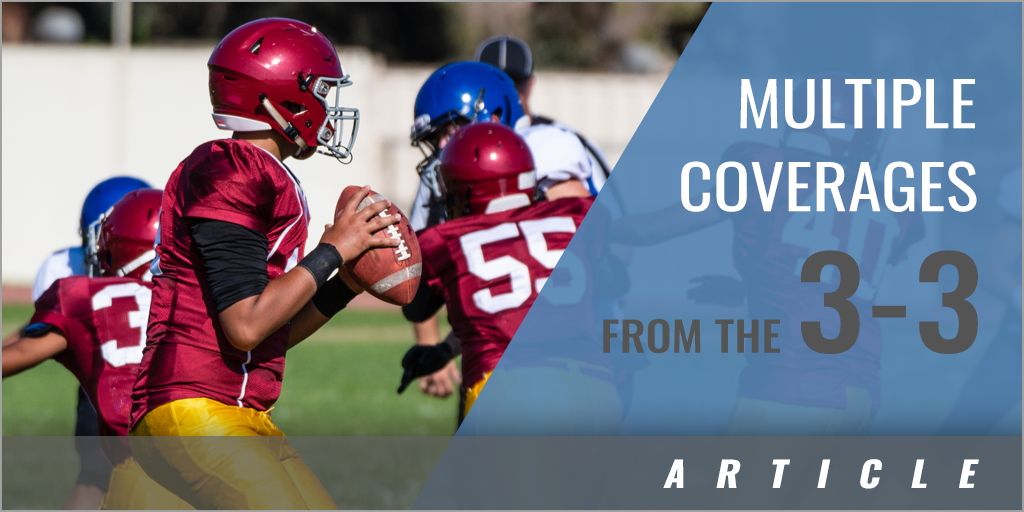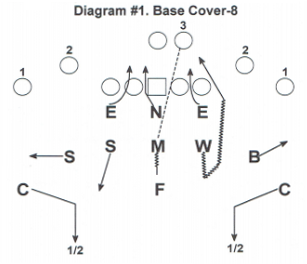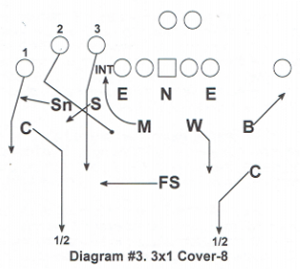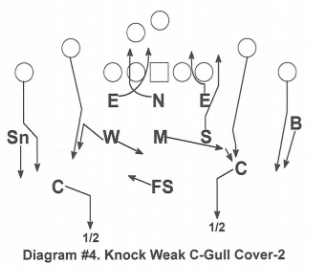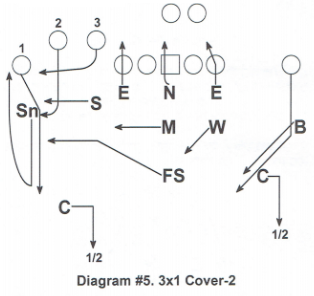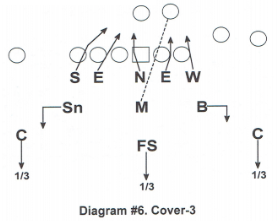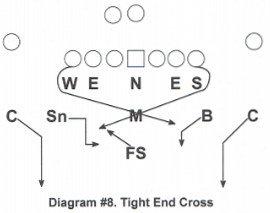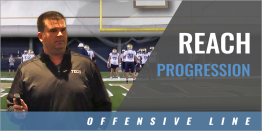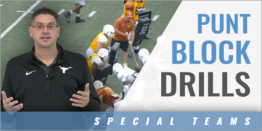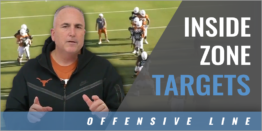|
By: Adam Barth - Cathedral HS (IN) Originally Published in: 2020 Nike Coach of the Year Clinic Manual - by Earl Browning Provided by: Nike Coach of the Year Thank you, gentlemen, it is an honor to be here. What I am going to show you is something that we do not do every year. We do not do everything we have every single year. We have everything in our toolbox and can grab what we need. What you need is based on the players you have. Three things never change in our program. We rely on these things and talk about them a lot:
When we talk about what we are looking for in these spots, we use these skills. Nose: Ideally, I would like to have the guy we had last year. He was 5-11 and 330 pounds. What we normally get is a wiry 170 pounder with good quickness. The smaller players will slant, and the bigger ones read. Ends: We can flip them or not, it depends on the ability of the players. With our stand-up people, we get more confused trying to switch sides. These techniques are mirrors.
Sam Linebacker: Bigger and bulkier of the three backers. He is the linebacker that plays over the tight end at times. Will Linebacker: He plays on the weak side and is better at pass coverage than the Sam linebacker. If we have a trips set. we may put our Sam linebacker to the trips set so he does not have to drop into coverage.
Free Safety: Is rangy and a good tackler, he is the best tackler. This past season he was the best coverage free safety we have had. Corners: These are our half field players. They need to be rangy and faster players that can play half-field coverage. (Field or Boundary) This is the way we have done our personnel in the past. If it does not fit your personnel, you can make adjustments. If we have a problem, it is with the type of players that can set the edge and be good in coverage. Most of the coverages are underneath coverages. We had other free safeties that were not as good in coverage, but they were good downhill tacklers. If we are going to pick a player to play safety, it would be an outside linebacker type. These are the different coverages that we will use.
I will touch on most of these today. The base coverage we use most of the time is cover-8. We ran a lot more cover-2 this past season. We did not run much cover-3 this year, which is a three deep and three under package. We went to this coverage because we had some over-aggressive free safeties and the play-action pass was hurting us. The problem was they were looking in the backfield instead of their keys. We call cloud cover-6, it is a combination coverage. Red is a combination coverage. It does not change the techniques, but only the schemes. Cover-8
The Mike linebacker reads the #3 receiver. In this diagram, it is the running back. If the #3 receiver does anything but a hitch or something underneath, Mike becomes a screen player and quarterback spy. The Sam and Will are going to match the #2 receivers, they are going to keep them out of the seam area. We do not spot drop with our linebackers. The Bear and Snake align at five yards by two yards inside the #2 receiver. If the #2 receiver is attached in the formation. their alignment is 5x3 yards outside the receiver. They drop underneath the #1 receiver. They do not drop, they run straight to underneath the #1 receiver. After that straight run, they get into a trail technique on the #1 receiver. The safety is a pass defender and a run defender. (Diagram #1) We asked him to do both equally. The play of the safety is going to be week to week depending on what type of team we play. The three down linemen and three linebackers are the run defenders and responsible for gaps. The five secondary players are the primary pass unit. If we can add one of the defenders to the other parts, we are even better.
If we can add the free safety to the run game. we are better. If we can add the Sam or Will linebackers to the passing game. we are better. If the defenders' coverage is in the backfield. the defender becomes a screen or spy player. If there is a two running back formation. the safety is going to rob the #2 receiver. That means he keys the #2 and reacts to what he does. Robber coverage is behind the linebacker at 6 or 7 yards. If the #2 receiver is going vertical, the safety takes him man to man. If the #2 receiver goes to the flat, the safety is looking to get under the pattern of the #1 receiver. He wants to get between the quarterback and the receiver. If the #2 receiver goes vertical, the safety does not try to get on top of the receiver. We want him under the receiver forcing the ball to be thrown over him. That brings the corner into play on the ball. (Diagram #2)
With the RPO game, reading the offensive linemen is a hard read. However, the high hat read is easy. The Mike linebacker is going to take care of any scramble play. It is ridiculous for me to ask the ends to contain the quarterback. If he gets out, he becomes the problem of the Mike linebacker. Man coverage in this coverage is probably not a good option. We are playing safeties against slot receivers. When the offense comes out in 3x1 formation the safety's rules change. (Diagram #3) He robs #3, to #2, to #1. If #3 blocks, the safety goes to the #2 receiver and gets on his hip. He does not want to get over the top of the receiver. He is going to undercut anything and run to the outside. If #3 goes vertical, the free safety has him and gets in his hip pocket. He wants the ball thrown over the top. If the #2 receiver breaks to the inside, the Sam linebacker plays him and passes him on to the Mike linebacker. In cover-8 we do not need the Will and the Sam linebackers in coverage. The safety is playing the underneath coverage on the #2 receiver. Therefore. we can use them in the blitz game.
If they try to run both the #1 and #2 receivers deep on the corner, we have the safety playing under #2 and the Snake playing under #1. It is a hard trail technique for the outside linebacker, but it is a harder throw to drop the ball over defenders to receivers. If they both go deep the corner has to play the middle in between them. Cover - 2
In this coverage, the Snake and Bear turn into a 4-3 typical funnel corners. They align 5 yards by 1 yard outside the #1 receiver and force him to the inside. The Sam and Will linebackers are walling off the #2 receivers and keeping them out of the middle. The Mike linebacker drops with the #3 receiver or has the screen and spies the quarterback. The free safety's cover is still determined by the formation. He has the same rules as he did in cover-8. When playing the 2x2 formation, we apply the rules. (Diagram #4) This is called "Knock Weak C-Gull" cover-2. The knock weak is the Sam linebacker coming off the edge. The defensive end slants into the B-gap. The C-Gull is a strong side stunt with the end looping into the A-gap and the nose firing out into the face of the offensive tackle. In the secondary, we play cover-2. The Mike and Will linebackers' movement is to the side where the Sam blitzed from.
If we play cover-2 against a 3x1 set, we apply the rules. (Diagram #5) The snake and bear funnel the #1 receivers to the inside and play the flat technique. They are going to trail the #1 receiver up the field. The corners are playing their half-field coverage. The free safety is going to apply his rules. The #3 receiver went immediately to the flat. The free safety rule is to rob. Since #3 went to the flat he is going to rob the #2 receiver. The Sam linebacker covers the #3 receiver if he goes to the flat.
If they complete the flat throw, they have a two to three-yard gain. When a team sprints out with the ball, they are trying to create a flood type situation with their patterns. They will send one in the flat, one in the intermediate zone, and one deep pattern. We want to cover the intermediate pattern with the free safety. That leaves the snake with the #1 receiver with the corner. Cover-3
The bear and snake outside linebackers are going to be at 5 yards deep by 1 yard inside the #2 receiver. (Diagram #6) Their technique is seam/flat. When we play cover-3. we are generally going to bring five-man pressure. We probably have to match the offensive scheme with our stunts. We can bring five-man pressure and run cover-8 behind it.
The big thing about this coverage is to force the receivers off the seam. The outside linebackers have that job. The free safety has the middle third and the corners have the two outside thirds. If we play double tight ends, nothing changes too much. (Diagram #7)
I like to bring both the Sam and Will linebackers to the line of scrimmage and get into a 5-1 look. The defensive ends are B-gap players. The Sam and Will linebackers are the C-gap players. The Mike plays A-gap opposite the charge of the nose. The outside linebacker is the D-gap force player. We are sound against the run. In the passing game, I am worried about four verticals. (Diagram #8) With the outside linebacker aligned at five yards by three yards outside the tight end. it puts too much stress on the free safety. The outside linebacker is not going to chase any inside route by the #2 receiver. If it is a sprint or fake. the free safety is going to take the backside #2 receiver. If the tight ends run double crossing routes, the snake and bear will pass them off to the other defender. The free safety takes the crosser coming to the backside of the formation.
All we are telling the outside linebacker is to not let the #2 receiver get a free release. They want to reroute the receiver as they come down the field. Cloud Coverage
To the wide side of the field, we are going to run cover-8. (Diagram #9) To the short side, you can run whatever you want to. You can run cover-2 or cover-3. Where the change comes in is the free safety. The free safety is going to rob the #2 to the cloud. We can change that by scouting report. However, he is going to the most dangerous receiver.
That is just a look at what we do. You might like it, or you might think it is crazy. I am not trying to sell you on changing the way you do things. This is just different. I am open to sharing anything we have. Most of us are willing to share any information we have. Any defense boils down to the personnel you have. Does anyone have any questions? I appreciate you sitting through this and thank you. |
